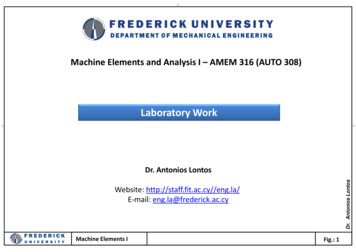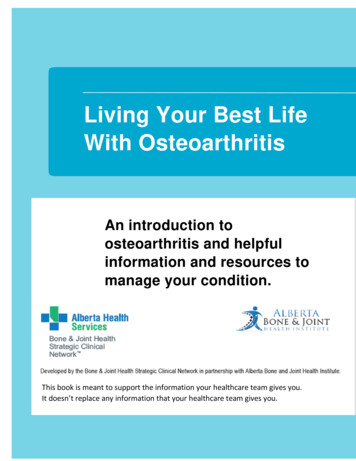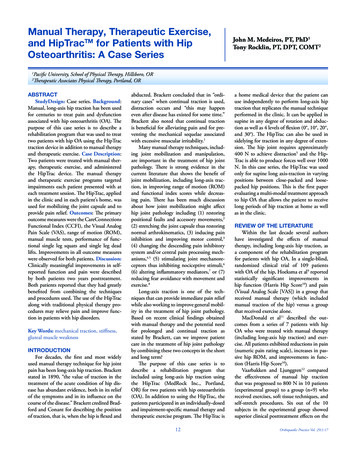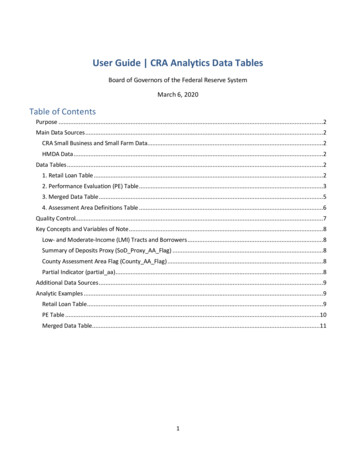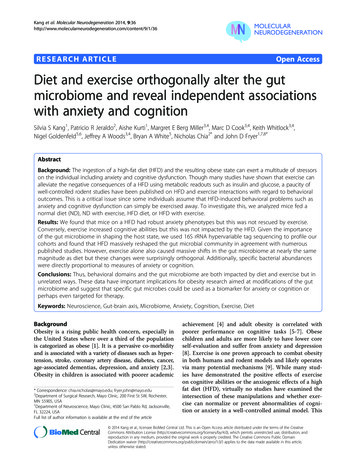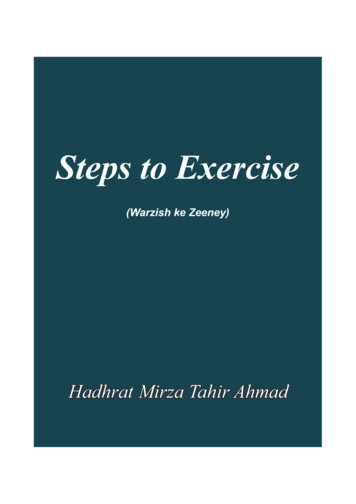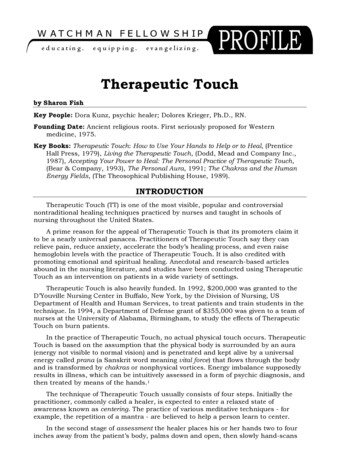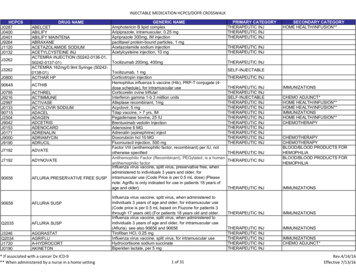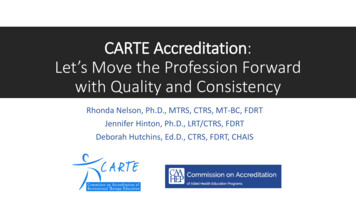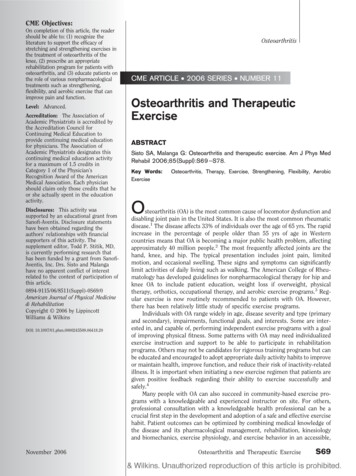
Transcription
CME Objectives:On completion of this article, the readershould be able to: (1) recognize theliterature to support the efficacy ofstretching and strengthening exercises inthe treatment of osteoarthritis of theknee, (2) prescribe an appropriaterehabilitation program for patients withosteoarthritis, and (3) educate patients onthe role of various nonpharmacologicaltreatments such as strengthening,flexibility, and aerobic exercise that canimprove pain and function.Level: Advanced.Accreditation: The Association ofAcademic Physiatrists is accredited bythe Accreditation Council forContinuing Medical Education toprovide continuing medical educationfor physicians. The Association ofAcademic Physiatrists designates thiscontinuing medical education activityfor a maximum of 1.5 credits inCategory 1 of the Physician’sRecognition Award of the AmericanMedical Association. Each physicianshould claim only those credits that heor she actually spent in the educationactivity.Disclosures: This activity wassupported by an educational grant fromSanofi-Aventis. Disclosure statementshave been obtained regarding theauthors’ relationships with financialsupporters of this activity. Thesupplement editor, Todd P. Stitik, MD,is currently performing research thathas been funded by a grant from SanofiAventis, Inc. Drs. Sisto and Malangahave no apparent conflict of interestrelated to the context of participation ofthis article.0894-9115/06/8511(Suppl)-0S69/0American Journal of Physical Medicine& RehabilitationCopyright 2006 by LippincottWilliams & WilkinsDOI: 10.1097/01.phm.0000245509.06418.20November 2006OsteoarthritisCME ARTICLE 2006 SERIES NUMBER 11Osteoarthritis and TherapeuticExerciseABSTRACTSisto SA, Malanga G: Osteoarthritis and therapeutic exercise. Am J Phys MedRehabil 2006;85(Suppl):S69 –S78.Key Words:ExerciseOsteoarthritis, Therapy, Exercise, Strengthening, Flexibility, AerobicOsteoarthritis (OA) is the most common cause of locomotor dysfunction anddisabling joint pain in the United States. It is also the most common rheumaticdisease.1 The disease affects 33% of individuals over the age of 65 yrs. The rapidincrease in the percentage of people older than 55 yrs of age in Westerncountries means that OA is becoming a major public health problem, affectingapproximately 40 million people.2 The most frequently affected joints are thehand, knee, and hip. The typical presentation includes joint pain, limitedmotion, and occasional swelling. These signs and symptoms can significantlylimit activities of daily living such as walking. The American College of Rheumatology has developed guidelines for nonpharmacological therapy for hip andknee OA to include patient education, weight loss if overweight, physicaltherapy, orthotics, occupational therapy, and aerobic exercise programs.3 Regular exercise is now routinely recommended to patients with OA. However,there has been relatively little study of specific exercise programs.Individuals with OA range widely in age, disease severity and type (primaryand secondary), impairments, functional goals, and interests. Some are interested in, and capable of, performing independent exercise programs with a goalof improving physical fitness. Some patterns with OA may need individualizedexercise instruction and support to be able to participate in rehabilitationprograms. Others may not be candidates for rigorous training programs but canbe educated and encouraged to adopt appropriate daily activity habits to improveor maintain health, improve function, and reduce their risk of inactivity-relatedillness. It is important when initiating a new exercise regimen that patients aregiven positive feedback regarding their ability to exercise successfully andsafely.4Many people with OA can also succeed in community-based exercise programs with a knowledgeable and experienced instructor on site. For others,professional consultation with a knowledgeable health professional can be acrucial first step in the development and adoption of a safe and effective exercisehabit. Patient outcomes can be optimized by combining medical knowledge ofthe disease and its pharmacological management, rehabilitation, kinesiologyand biomechanics, exercise physiology, and exercise behavior in an accessible,Osteoarthritis and Therapeutic ExerciseS69
Authors:Overview of Comprehensive ExerciseSue Ann Sisto, PT, MA, PhDGerard Malanga MDGenerally speaking, a comprehensive exerciseprogram should involve exercises that improvefunctional capacity first, with a secondary focus onphysical fitness so that the patient may engage inactivities of daily living without undue pain orfatigue. Exercises should progress from flexibilityof the affected joints to prevent joint contracture,to strengthening exercises focusing on functionaltasks that enhance muscle endurance and contraction speed, to aerobic exercises, either weightbearing or non–weight bearing, such as aquaticexercise. Initially, the exercise program shouldprogress more conservatively to monitor symptomexacerbation indicating adaptability to increasedphysical demand, and also to encourage exercisecompliance.6Affiliations:From the Department of Physical Medicine andRehabilitation (SAS, GM), University of Medicine andDentistry of New Jersey, New Jersey Medical School; theSchool of Nursing and Allied Health Professions,Department of Physical Therapy (SAS), New JerseyInstitute of Technology (SAS), Department of BiomedicalEngineering, Newark, New Jersey; Columbia University(SAS), Department of Physical Therapy, New York, NewYork; Department of Pain Management, OverlookHospital (GM), Summit, New Jersey; and Department ofSports Medicine, Mountainside Hospital (GM),Mountainside, New Jersey.Correspondence:All correspondence and requests for reprints should beaddressed to Sue Ann Sisto, PT, MA, PhD, Director,Human Performance and Movement AnalysisLaboratory, Kessler Medical Rehabilitation Researchand Education Corporation (KMRREC), 1199 PleasantValley Way, West Orange, NJ 07052.enjoyable, and affordable setting. Such collaboration provides a supportive environment in whichthe person with OA can experience success andlearn to maintain self-directed regular exercise andappropriate physical activity.4The definition of an effective rehabilitationprogram has not been universally agreed upon;however, there is some evidence supporting somerehabilitation approaches for OA. Hurley et al.5 goso far as to say that “failure to recommend exerciseto our patients is professional negligence.”The primary goals in the rehabilitation of patients with OA are to (1) educate patients on thedisease process and joint preservation to prevent ordecrease pain, (2) improve flexibility, and (3) increase static and dynamic muscle strength. Thesetherapeutic interventions are designed to alter thedetrimental and inefficient biomechanics throughout the entire kinetic chain, including the ankle,knee, and hip joints. Therefore, this review willfocus on the evidence supporting or refuting therapeutic exercises that impact this lower-limb kinetic chain for patients with OA. The majority ofthe evidence focuses on the knee; consequently,paper will discuss more on the knee joint becauseless literature is available on therapeutic exercisesfor the hip and ankle. The exercises reviewed include range of motion (ROM), strengthening, gaittraining, aerobic exercise, and multimodal rehabilitation exercise. The exercises reviewed are not intended to be comprehensive but to highlight somesuggested therapeutic exercises in each category.S70Sisto et al.Warm-Up Exercise PhaseAn exercise program should include periods ofwarm-up, aerobic exercise, and cool-down that include individualized, therapeutic exercises to improveor maintain flexibility, ROM, muscle strength andendurance, and cardiovascular fitness and health. Thewarm-up period prepares the body for more vigorousactivity. The warm-up routine can be designed toinvolve ROM, stretching of the affected joints, andstrengthening of various muscle groups.The aerobic exercise component provides the stimulus foradaptation and training of cardiovascular efficiency, aerobic endurance, and activity tolerance.This should include exercise activities that havedemonstrated safety and effectiveness in OA, including limiting repetitive weight-bearing exercises and using aquatic aerobic exercise, and stationary cycling. Once a person is able to perform 10mins or more of aerobic activity at an intensity of70% or more of age-predicted maximal heart rate(moderate intensity), a 3- to 5-min active cooldown is recommended.6 As with the warm-up period, low-intensity cool-down activities can be designed and used in a daily program that providesgeneral as well as therapeutic benefit. In general,warm-up aerobic exercises can make soft tissuemore pliable by centrally heating the body, therebypreparing the body for flexibility exercises. Each ofthe therapeutic exercise components of flexibility,strengthening, and aerobic exercise, as well asmixed programs, will be discussed individually.Flexibility ExercisesIncreasing ROM has been shown to improvediscomfort and result in an increase in function.7Flexibility limitations contribute to mobility deficits for patients with OA at some point during thecourse of the disease process. These deficits resultfrom a combination of shortened muscles and jointAm. J. Phys. Med. Rehabil. Vol. 85, No. 11 (Supplement)
restrictions, which result in inflexibility. Additionally, ROM in one joint of the lower limbs is associated with an alteration in ROM in other jointsalong that kinetic chain. For example, when OA ispresent in the knee, adaptive changes of the ankleand hip (often decreased ROM) occur. These limitations result in a reduction in overall kinematicsof movement such as seen during gait,8 resultingin an overall reduction in gait velocity. Flexibilityexercises involve stretching of shortened musculotendinous structures, thereby increasing jointROM as long as the joint is not obstructed bycalcifications or OA-related bony changes. Thereare capsular patterns of loss of ROM at the hip thatusually begin first with loss of rotation, most ofteninternal rotation, and are later followed by a decrease in abduction and hip flexion.9 Musculartightness is then superimposed onto these jointcapsule restrictions. Exercises should be chosen tospecifically address these patterns of inflexibility.There are several principles to consider whenimplementing ROM and stretching exercises to improve flexibility in the treatment of patients withOA. First, all affected joints should move throughtheir full available ROM at least once per day,although it has also been suggested that flexibilityexercises should be performed as many as three tofive times a day. Second, all major muscle groupsthat cross the affected joint(s) should be stretcheddaily.6 Forcing a joint through its ROM should beavoided.Independent or home flexibility exercises forthe hip may include hip abduction in sitting tosquatting from a stance position to increase abduction and external rotation. Increases in abductioncould be promoted through “V” sitting or “longsitting” with the legs separated. Patients are askedto reach between their legs, gradually stretchingthe adductors and avoiding stretching the upperback by leaning with the trunk forward, withoutcurving the spine. Patients should avoid bouncingto stretch and instead slowly move to a slightlyuncomfortable point in the ROM. They should holdthat position for at least 30 secs and repeat it threetimes daily.7 Severe discomfort should be avoided.For the knee, it is critical to stretch the hamstringsand the quadriceps. This can be accomplishedthrough hanging the affected leg over the edge of abed with the knee flexed. The patient should attempt to pull the lower leg into greater knee flexion by activating the hamstrings. This may resultin reciprocal inhibition of the quadriceps, allowingfor greater stretching of the quadriceps. The patient should simultaneously attempt to press theback of the thigh into the surface toward hip extension, thus enabling stretching of the quadricepsacross the anterior hip region. This maneuver alsoNovember 2006encourages increased hip extension by stretchingthe rectus femoris across the hip.To stretch the hamstrings, the patient shouldlie in a supine position with a towel wrappedaround the foot. The leg is fully extended at theknee and then is lifted up from the resting positionuntil the stretch is felt behind the knee.Strengthening ExercisesOptimal ROM is needed for functional performance so that strengthening can be optimizedthroughout the greatest available motion. Therefore, it is important to perform flexibility exercisesbefore or in conjunction with strengthening exercises. Research focusing on resistance exercises hasshown that patients with OA have dramatic improvements in muscle strength, muscle endurance,and contraction speed of the muscles surroundingthe arthritic joint.6,10 Several studies have evaluated deficits in quadriceps strength, which is associated with knee OA.11–13 Slemenda et al.14 studiedthe relationship of quadriceps strength and obesitywith the risk for the development of knee OA in 342elderly community dwellers. Strength was measured by isokinetic dynamometry, and musclemass was measured by dual-energy x-ray absorptiometry to adjust for muscle-mass differencesacross subjects. After accounting for body weight,there was an 18% reduction in quadriceps strengthfor those individuals who later developed radiographic evidence of knee OA, which occurred approximately 2.5 yrs later in women. However, whenaccounting for muscle mass, quadriceps strengthwas only 15% lower in the women who later developed knee OA, and this relationship was nolonger significant. There was a strong negativecorrelation of obesity and a reduction in quadricepsstrength in a subset of the women (r 0.74).This was in contrast to men, in whom increasedmuscle strength correlated positively with increased obesity, although this was a more modestcorrelation. The authors concluded that weakquadriceps in combination with obesity may be arisk factor for the development of knee OA inwomen.Although quadriceps weakness has been widelyreported in patients with knee OA, there is somedisagreement as to whether muscle weakness is thecause of OA and/or the cause of its progression.Brandt et al.15 explored the relationship betweenlower-limb weakness and the progression of established radiographic changes of knee OA when definite unilateral radiographic changes were present.Mean peak strength of women with progressive OA,measured by isokinetic dynamometry (controllingfor muscle mass measured by dual-energy x-rayabsorptiometry), was about 9% lower than in thosewith stable radiographic changes, but this differOsteoarthritis and Therapeutic ExerciseS71
ence was not statistically significant. This decreasein quadriceps strength in women with progressiveOA did not seem to be attributable to knee pain orknee strength at baseline compared with thosewith radiographically stable OA. These results suggest that factors other than quadriceps weaknessare important determinants of OA progression.Weakness of the quadriceps has also been reported to be associated with pain.16 The weaknessof the quadriceps has been suggested to be eitherthe result of disuse atrophy secondary to knee painand muscle inhibition from the knee or from theprimary joint pain dysfunction leading to inactivityand functional weakness from disuse atrophy. Regardless of its origin, weakness can put a patient atrisk for further pain, progression of joint damage,and, if left untreated, disability.7There are fewer studies on the effect of exercisetherapies for hip OA compared with studies forknee OA. In addition, few studies have evaluatedthe long-term effects of such programs for hip OA.Tak et al.17 evaluated the effect of and 8-wk exerciseprogram for 109 people with clinical symptoms ofhip OA who were randomized into a group exerciseprogram focused on improving the symptoms ofhip OA or into a standard care group. Exerciseswere implemented once a week and includedstrengthening using fitness equipment such as pulleys, a bowflex, and a treadmill. Using the HarrisHip Score, there was a greater reduction in painsustained at the 3-mo follow-up (average HarrisHip Score was 3.8 at baseline, 3.6 after the exercisetraining program, and 3.5 at the 3-mo follow-up) inthe exercise group compared with the standardcare group (average Harris Hip Score was 4.2 atbaseline, 4.1 after the exercise training program,and 5.1 at the 3-mo follow-up). Using the SicknessImpact Profile (physical activity subscale), therewas a reduction of the impact of OA on disability atfollow-up (7.2 to 5.1, respectively). Using the Groningen Activity Restriction Scale, there was a trendof decreased self-report disability noted at the 3-mofollow-up. Using the timed Up & Go test, the exercise group was significantly better than the controlgroup at follow-up, with a tendency (nonsignificant) to have an improved walking speed (averagetimed Up & Go was 10.4 secs at baseline, 10.1 secsafter the exercise training program, and 9.4 secs atthe 3-mo follow-up). The results of this study provide evidence of the benefit of exercise on painreduction and hip function, which are importantfactors in the onset or maintenance of disability.van Baar et al.18 studied the effectiveness ofexercise in patients with hip or knee OA. Theirprimary outcome measures were pain during thepast week using a visual analog scale (VAS), use ofnonsteroidal antiinflammatory drugs, and observeddisability measured by video reviews of standard-S72Sisto et al.ized timed tasks. The patients in the exercise groupwere given exercise treatment individually by aphysiotherapist. The treatment included exercisesfor muscle strength and flexibility, mobility, andlocomotion. Sessions ranged from one to threetimes a week, depending on the pain level, andlasted approximately 30 mins for up to 12 wks, witha follow-up at 24 wks. Patients in the control groupwere provided education and medication if necessary. Patients were instructed to use as little medication as possible. A brochure was provided forpatient education, covering diagnosis, prognosis,advice about rest, daily activities and diet, the useof aids, and medical treatment. No advice aboutexercise was included. Results from this study indicated that there were beneficial effects of exerciseon pain during the past week at 12 wks, but thatthese effects had declined at 3 mos, indicating asmall to moderate statistical effect size (0.58 aftertreatment to 0.36 at 3-mo follow-up). No effectswere found for nonsteroidal antiinflammatory druguse and observed disability. At 9 mos, there was nosignificant difference found between the groups.Furthermore, a prognostic analysis of patient characteristics at baseline compared with at 3- and6-mo follow-up determined that there was a benefitof exercise for patients who were overweight atbaseline. Patients who had a body mass index of 30or greater at baseline compared with at the follow-up periods benefited more from exercise thanthose who were not obese. Similarly, patients whoreported a lower level of pain-coping strategy atbaseline compared with at the follow-up periodsimproved in pain levels more than those who didnot report problems with pain-coping strategies.Although there was a 66% level of exercise compliance (measured during the therapy period, notduring long-term follow-up), there was no relationship to long-term beneficial outcome or reduced pain and disability as a result of exerciseafter treatment. The authors conclude that theirresults support the usefulness of exercise in patients with OA of the hip or knee but that the effectof reduced pain and disability is diminished overtime. The authors suggest future research to evaluate the benefits of intermittent exercise boostersessions that take into account optimal content ofthe exercise program, such as type and dosing ofeach component of the exercise program. Additionally, the authors suggest that the timing of aninterim booster session and of short- and longterm follow-ups to enhance the retention of thesepositive findings warrant further study.Deficits in sensorimotor function and kneejoint proprioception have been observed in patientswith unilateral OA and have also been reported tobe associated with quadriceps weakness. A reduction in quadriceps motor neuron excitability com-Am. J. Phys. Med. Rehabil. Vol. 85, No. 11 (Supplement)
pared with that of healthy controls resulted inreduced quadriceps activation and strength andalso joint position sense (JPS).19,20 This weaknessand reduced proprioception was correlated with areduction in self-report and objective functionalperformance measures, such as the “get up and go”test. JPS was measured using an electrogoniometer. The participant was asked to match the kneeposition to that identified by the investigator previously with the participant’s eyes closed to determine the error between the tester’s knee-joint angle vs. the participant’s matched knee-joint angle.The authors suggested a potential for reduced postural stability and functional performance in patients with OA and with loss of sensorimotor function and knee proprioception. Hurley and Scott10later reported improvements in knee JPS and position sense after an exercise program emphasizingisometric exercises to the quadriceps, bicycleriding to increase knee ROM, concentric/eccentricknee contractions using elastic bands to increasedynamic control, and functional activities such assit-to-stand exercises, twice weekly for 5 wks.Bennell et al.21 evaluated the relationship ofsensorimotor function with knee-joint kinematicsduring gait. The authors measured knee-joint proprioception or JPS using kinematic markers on thehip, knee, and ankle. The authors found a weak butsignificant association with knee JPS and kneekinematics during gait. The authors suggest thatthis finding may be attributable to prepositioningof the knee in extension just before the loadingresponse to maintain the knee in a stable positionduring the stance phase of gait, because of the lackof proprioception. Riskowski et al.22 also foundthat individuals with greater knee extension justbefore initial contact of the foot during gait hadboth a higher rate of loading and poorer proprioception. These studies underscore the importance of the evaluation of joint proprioception inOA and of designing treatments to enhance proprioceptive feedback during functional taskssuch as ambulation.Strengthening techniques should focus initiallyon the quadriceps and hamstrings, but ultimately, astrengthening program that incorporates the entirekinetic chain is needed. Early on in the rehabilitationprocess, gentle isometric exercises, such as “quadsets,” can help minimize pain and improve confidence. Quad sets involve isometric contraction of thequadriceps muscles against a fixed surface that can beflat or wedged with a towel roll or rigid foam wedgeto accommodate flexion contractures. These can beprogressed to straight-leg raises and “wall sits.”Straight-leg raises are performed in the supine position with the opposite knee bent to protect the backfrom excessive lordosis and discomfort. The leg israised with the knee straight by activating the quadNovember 2006riceps muscles, particularly the rectus femoris, whichgenerates hip flexion when the knee is extended. Wallsits are controlled isometric squat exercises in whichbody weight and gravity are used as the resistiveforces at a particular point in the ROM. The wallprovides support for balance and assumes a portion ofthe body weight. Patients can gradually increase thedepth of the “wall sit” as quadriceps strength andknee ROM improves. Care should be taken to avoidvalgus and varus stresses by using foot wedging tocounteract the medial and lateral forces. A close monitoring of the pain response must be maintainedbefore progressing the level of difficulty.The exercise regimen should then be progressed to isotonic exercises such as knee-flexionand -extension exercises with increasing resistanceto fatigue. Ultimately, strength training shouldprogress to closed kinetic chain exercises becausethey involve multiple muscle groups of multiplejoints of the lower limb and replicate how thesemuscles are used in daily activities such as gettingup from a chair or climbing up stairs. These exercises include squats and wall slides that can beprogressed to lunges if isometrics are toleratedwell.Fisher6 emphasized contraction speed as another aspect of muscle training that is often overlooked but that should be added to the progressionof exercises. The author points out that musclecontraction speed is important for high-speedfunctional tasks such as crossing a street with atraffic light, and for fall prevention. These exercisesshould be performed in a cautious manner to protect the arthritic joint. This could be accomplishedthrough isokinetic devices by which the speed ofthe motion is preset, or simply by asking the patient to perform contractions through the availableROM as quickly as possible.The Ottawa Panel reported evidence-basedclinical practice guidelines for therapeutic exercises and manual therapy in the management ofOA.23 Using the Cochrane methodology, the Ottawa methods group synthesized evidence fromrandomized controlled trials and then asked stakeholders to nominate representatives to serve aspanels of experts. This panel agreed on gradingcriteria to evaluate the evidence. Of 609 potentialstudies, 26 randomized controlled trials and controlled clinical trials were reviewed. The panelidentified 16 positive recommendations for therapeutic exercises, especially strengthening and general physical activity for the management of painand for the improvement of functional capacity.Manual therapy combined with exercises wasalso recommended. Limitations reported by thepanel in their review included the need for moreprecise descriptions of the characteristics of thetherapeutic application such as dose, type andOsteoarthritis and Therapeutic ExerciseS73
frequency of exercise employed, and the intensityof its application.Aerobic ExerciseOnce the muscles’ strength, endurance, andcontraction speed have been improved sufficientlyand can be used without exacerbation of symptoms, aerobic exercises can be added to the progression of exercises. Previous research has shownthat patients with OA can benefit from aerobicexercises, including cycle ergometry.24 Aerobic fitness exercise training programs have been shownto reduce pain and morning stiffness and improvewalking speed and balance over an extended period.Minor et al.25 studied a group of 120 patients witheither rheumatoid arthritis or OA who were randomly assigned to either an aerobic or nonaerobicexercise program for 12 wks. The aerobic groupthat participated in walking and aquatics showedsignificant improvement in the 50-ft walking time,exercise aerobic capacity, and other quality-of-lifemeasures. There were no significant differences inflexibility, number of clinically active joints, orduration of morning stiffness, but the authorspoint to the feasibility and tolerance to the aerobicprogram (83% retention) for patients with OA.Minor4 later reported walking as a safe, effective,and accessible form of cardiovascular exercise forpeople with knee, hip, and spinal OA.Coleman et al.26 studied the effect of aerobicexercise in patients with knee OA. The authorsexamined 100 people between the ages of 68 and85, about half of whom reported mild to moderateOA and who received 6 mos of resistance and/oraerobic exercise and found improved strength andendurance. Joint symptoms fluctuated similarly inthose with and without arthritis. The rate of musculoskeletal injuries that required reduction or discontinuation of exercise for at least 1 wk was lessthan 0.5% underscoring the notion that properlyperformed conditioning exercise does not necessarily exacerbate joint symptoms in OA and may reflect a normal fluctuation of joint discomfort overtime. It was also noted that although there mayhave been aerobic benefits, such as an increases inpeak oxygen consumption, there was not as muchimprovement in muscle strength or endurance.26Others have reported that improvements in aerobiccapacity are associated with decreases in pain.27,28Fisher6 points out that prescribed aerobic activitybe selected based on patient preference. For example, a patient may not be compliant with aquaticexercises if he or she is uncomfortable wearing abathing suit in public. Generally speaking, aerobicexercises should be implemented at the lower target heart rate ranges and then progress to thecardiovascular training ranges (70 – 85% maximalheart rate).S74Sisto et al.Brosseau et al.29 completed a meta-analysis onthe efficacy of aerobic exercises for OA using theCochrane Collaboration methodology. Twelve trialswere identified that included 1363 patients undergoing aerobic physical activities, including walkingaquatics (walking in water) and Tai Chi. The currentdebate that stimulated the need for this review is notwhether therapeutic exercises benefit patients withOA, but, rather, what are the most effective exercisesfor each stage of the disease, and what are the beststrategies to motivate patients for lifelong regularphysical activity. The review focused on aerobic exercises, although some studies combined aerobic exercises with strengthening and ROM exercises. In general, aerobic exercises such as walking or jogging inwater were found to have beneficial effects on pain,joint tenderness, functional status, and respiratorycapacity for patients with OA. When strengtheningand aerobic exercise were compared, strengtheningseemed to provide a superior benefit to short-termoutcomes that improved impairments such as pain,whereas aerobic exercise had a greater benefit inlong-term functional outcomes. Still,
Dentistry of New Jersey, New Jersey Medical School; the School of Nursing and Allied Health Professions, Department of Physical Therapy (SAS), New Jersey . Mountainside, New Jersey. Correspondence: All correspondence and requests for reprints should be addressed to Sue Ann Sisto, PT, MA, PhD, Director,

